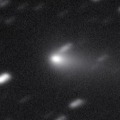
|
The brightness evolution has slowed down just before the perihelion passage. But now it is bright as 7.1 mag (Sept. 7, Marco Goiato). In the Southern Hemisphere, it is observable in the morning sky until mid September. Then it is observable in the evening sky from late September to mid October. In the Northern Hemisphere, it will be unobservable soon.
Date(TT) R.A. (2000) Decl. Delta r Elong. m1 Best Time(A, h)
Sept. 6 7 42.17 -8 7.6 0.678 0.784 50 6.6 4:09 (289, 13)
Sept.13 9 14.19 -22 5.8 0.507 0.706 40 5.5 4:15 (292, -6)
|

|
Appearing in the morning sky again. Now it is so bright as 7.1 mag (Sept. 6, Marco Goiato). It will be observable in good condition in the Southern Hemisphere after this. But it keeps low in the Northern Hemisphere.
Date(TT) R.A. (2000) Decl. Delta r Elong. m1 Best Time(A, h)
Sept. 6 8 59.99 4 43.6 1.823 1.066 29 7.0 4:09 (267, 4)
Sept.13 8 54.11 1 11.3 1.703 1.089 37 7.0 4:15 (276, 10)
|
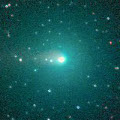
|
It brightened up to 6.0 mag from July to August (July 24, Maik Meyer). It will be fading after this. But it is bright as 7.4 mag still now (Sept. 10, Marco Goiato). It keeps observable in good condition until November in the Southern Hemisphere, or December in the Northern Hemisphere.
Date(TT) R.A. (2000) Decl. Delta r Elong. m1 Best Time(A, h)
Sept. 6 20 20.98 44 39.0 0.634 1.420 117 7.3 21:15 (180, 81)
Sept.13 19 40.45 30 30.2 0.777 1.523 116 8.2 20:09 ( 0, 85)
|
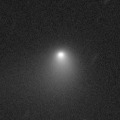
|
Now it is bright as 9.6 mag (Sept. 6, Marco Goiato). But the brightness evolution is slower than expected. It keeps observable in good condition until early November in the Southern Hemisphere. In the Northern Hemisphere, it is not observable now. It is observable only in the evening low sky from late September to mid November. But it will be observable in excellent condition after 2015 January while the comet will be fading. It will pass extremely close to Mars on Oct. 19.
Date(TT) R.A. (2000) Decl. Delta r Elong. m1 Best Time(A, h)
Sept. 6 21 10.00 -73 31.2 0.891 1.569 111 8.4 21:54 ( 0,-18)
Sept.13 19 2.46 -64 21.8 0.928 1.526 104 8.4 19:36 ( 1, -9)
|
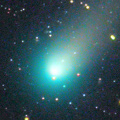
|
It brightened rapidly in outburst in mid October in 2013. It will be fading gradually after this. But it is bright as 10.5 mag still now (Aug. 20, Marco Goiato). In the Southern Hemisphere, it keeps observable in good condition for a long time until the comet fades out. In the Northern Hemisphere, it keeps extremely low after this.
Date(TT) R.A. (2000) Decl. Delta r Elong. m1 Best Time(A, h)
Sept. 6 21 46.46 -51 15.0 2.163 2.944 132 11.0 22:44 ( 0, 4)
Sept.13 21 41.91 -51 29.9 2.284 3.010 128 11.2 22:12 ( 0, 4)
|
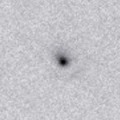
|
Now it is 14.7 mag (Aug. 29, iTelescope Observatory, Mayhill). In the Northern Hemisphere, it will be observable at 12-13 mag in excellent condition from 2014 summer to 2015 spring. In the Southern Hemisphere, it will locate low around the highlight.
Date(TT) R.A. (2000) Decl. Delta r Elong. m1 Best Time(A, h)
Sept. 6 7 50.35 25 41.2 2.558 2.036 48 13.4 4:09 (258, 30)
Sept.13 8 8.08 25 18.6 2.495 2.026 51 13.4 4:15 (260, 33)
|
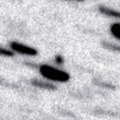
|
Now it is 13.9 mag (Aug. 29, iTelescope Observatory, Mayhill). It keeps observable for a long time after this while the comet will be fading gradually.
Date(TT) R.A. (2000) Decl. Delta r Elong. m1 Best Time(A, h)
Sept. 6 7 55.43 13 52.3 2.491 1.922 45 13.4 4:09 (269, 23)
Sept.13 8 10.15 12 52.4 2.473 1.956 48 13.6 4:15 (272, 26)
|

|
Now it is 12.8 mag (Aug. 19, Marco Goiato). It keeps bright as 13-14 mag for a long time from 2013 to 2014.
Date(TT) R.A. (2000) Decl. Delta r Elong. m1 Best Time(A, h)
Sept. 6 20 29.17 -30 47.0 2.340 3.159 137 13.8 21:27 ( 0, 24)
Sept.13 20 27.85 -30 34.9 2.416 3.167 130 13.9 20:59 ( 0, 24)
|

|
No bright outburst was reported in July and August. It will be unobservable in mid September in the Northern Hemisphere, or in late October in the Southern Hemisphere.
Date(TT) R.A. (2000) Decl. Delta r Elong. m1 Best Time(A, h)
Sept. 6 15 30.83 -27 35.8 6.311 6.113 74 13.9 19:47 ( 43, 12)
Sept.13 15 34.48 -27 37.6 6.413 6.112 68 13.9 19:36 ( 45, 10)
|

|
It brightened rapidly as expected, however, it reached only up to 11.8 mag at best, fainter than expected by 2 mag (Aug. 19, Ken-ichi Kadota). It will never be observable after this.
Date(TT) R.A. (2000) Decl. Delta r Elong. m1 Best Time(A, h)
Sept. 6 10 22.85 13 12.3 1.636 0.673 10 14.1 4:09 (248, -7)
Sept.13 10 57.28 10 44.1 1.740 0.765 9 15.2 4:15 (250, -9)
|

|
New bright comet. Now it is 14.6 mag (Aug. 23, iTelescope Observatory, Siding Spring). It will approach to the earth in December and January, and it is expected to brighten up to 8 mag. In the Southern Hemisphere, it keeps observable in excellent condition until late January. In the Northern Hemisphere, it keeps extremely low until mid December. But after that, it will be observable in excellent condition.
Date(TT) R.A. (2000) Decl. Delta r Elong. m1 Best Time(A, h)
Sept. 6 7 16.42 -41 30.2 2.585 2.427 69 14.4 4:09 (318, -5)
Sept.13 7 25.69 -41 33.4 2.490 2.353 70 14.2 4:15 (322, -2)
|
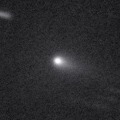
|
Now it is 14.2 mag (Aug. 28, Jakub Cerny). It is observable at 14 mag in excellent condition until November.
Date(TT) R.A. (2000) Decl. Delta r Elong. m1 Best Time(A, h)
Sept. 6 23 59.48 -3 50.4 1.300 2.287 164 14.5 1:01 ( 0, 51)
Sept.13 23 57.07 -4 31.3 1.301 2.301 171 14.5 0:31 ( 0, 51)
|

|
Now it is 13.6 mag (Aug. 27, Sandor Szabo). It keeps bright at 13-14 mag for a long time until 2014.
Date(TT) R.A. (2000) Decl. Delta r Elong. m1 Best Time(A, h)
Sept. 6 18 26.24 -6 22.9 6.317 6.769 112 14.5 19:47 ( 8, 48)
Sept.13 18 23.84 -7 9.2 6.453 6.792 105 14.5 19:36 ( 15, 47)
|
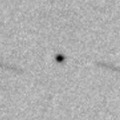
|
Now it is 14.2 mag (Aug. 28, Jakub Cerny). Getting brighter than originally expected, and it is already visible visually. It is expected to brighten up to 4 mag from autumn to winter in 2015. It is observable in good condition in the Southern Hemisphere until the highlight, or in the Northern Hemisphere after the highlight.
Date(TT) R.A. (2000) Decl. Delta r Elong. m1 Best Time(A, h)
Sept. 6 23 27.25 -20 30.0 4.641 5.619 164 14.6 0:29 ( 0, 35)
Sept.13 23 20.55 -21 23.4 4.584 5.552 162 14.5 23:50 ( 0, 34)
|

|
New bright comet. Now it is 14.5 mag (Sept. 6, C. Rinner, F. Kugel). It keeps 13-14 mag until 2015 spring. But it keeps locating low in the morning sky. In the Southern Hemisphere, it is too low to observe until December.
Date(TT) R.A. (2000) Decl. Delta r Elong. m1 Best Time(A, h)
Sept. 6 8 29.89 18 58.5 2.404 1.725 38 14.8 4:09 (259, 18)
Sept.13 8 52.29 18 4.2 2.321 1.671 39 14.6 4:15 (262, 20)
|
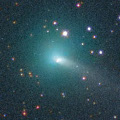
|
It brightened very rapidly, and brightened up to 9.4 mag in early July (July 4, Maik Meyer). However, it will be fading rapidly after this. It has already faded down to 11.9 mag (Aug. 27, Uwe Pilz), and 14.5 mag (Aug. 28, Jakub Cerny). It keeps observable until early September in the Southern Hemisphere, or until late September in the Northern Hemisphere.
Date(TT) R.A. (2000) Decl. Delta r Elong. m1 Best Time(A, h)
Sept. 6 13 58.18 14 19.4 1.992 1.463 44 14.6 19:47 ( 92, 22)
Sept.13 13 59.17 13 17.6 2.170 1.536 39 15.0 19:36 ( 93, 19)
|
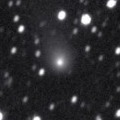
|
Now it is 14.2 mag (Aug. 27, Jakub Cerny). It keeps 13-14 mag and observable in good condition in the Northern Hemisphere for a long time from 2013 to 2014. In the Southern Hemisphere, it is not observable until 2014 autumn. The split fragment of 18 mag was observed on Aug. 27 (F. Manzini, V. Oldani, A. Dan, R. Crippa, R. Behrend), and it keeps visible at 19.5 mag still on Sept. 7 (G. Masi, P. L. Catalano, U. Masi).
Date(TT) R.A. (2000) Decl. Delta r Elong. m1 Best Time(A, h)
Sept. 6 23 56.17 50 14.2 3.533 4.153 121 14.6 0:58 (180, 75)
Sept.13 23 43.25 48 43.8 3.503 4.187 127 14.6 0:18 (180, 76)
|
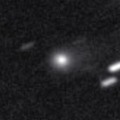
|
Now it is 14.9 mag (Aug. 12, Taras Prystavski). It is expected to brighten up to 13 mag and to be observable in good condition in 2015. It will be unobservable temporarily after mid September.
Date(TT) R.A. (2000) Decl. Delta r Elong. m1 Best Time(A, h)
Sept. 6 14 20.90 -4 43.8 4.508 3.967 51 14.8 19:47 ( 72, 16)
Sept.13 14 28.12 -5 24.6 4.551 3.936 47 14.7 19:36 ( 73, 14)
|

|
New bright comet. Now it is 14.9 mag (Aug. 6, Ken-ichi Kadota). It keeps 15 mag for a long time from 2014 to 2015. It is observable in excellent condition in 2014 in the Southern Hemisphere, or in 2015 in the Northern Hemisphere.
Date(TT) R.A. (2000) Decl. Delta r Elong. m1 Best Time(A, h)
Sept. 6 1 36.18 -36 15.1 3.459 4.214 133 14.9 2:38 ( 0, 19)
Sept.13 1 29.43 -36 14.3 3.403 4.192 136 14.9 2:03 ( 0, 19)
|

|
Big asteroid discovered in 1906. It suddenly showed the cometary activity on Dec. 11, 2010, probably due to an impact of a small object. It has already turned to be stellar.
Date(TT) R.A. (2000) Decl. Delta r Elong. m1 Best Time(A, h)
Sept. 6 4 50.46 18 32.0 3.251 3.397 89 15.0 4:09 (299, 62)
Sept.13 4 53.94 18 46.3 3.151 3.400 95 15.0 4:15 (311, 67)
|

|
It brightened up to 11-12 mag in 2012. Now it is 14.9 mag (Aug. 12, Taras Prystavski). Now it is not observable. It will be observable at 15 mag in good condition again in 2015.
Date(TT) R.A. (2000) Decl. Delta r Elong. m1 Best Time(A, h)
Sept. 6 11 55.82 -7 18.2 9.079 8.140 20 15.0 19:47 ( 91,-15)
Sept.13 11 57.39 -7 30.9 9.147 8.176 14 15.0 19:36 ( 93,-18)
|
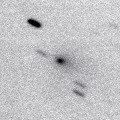
|
It brightened up to 2 mag by unusual major outburst in 2007. It is coming back now. Now it is 14.4 mag (Aug. 28, Jakub Cerny). In the Northern Hemisphere, it keeps observable until it fades out in 2015. In the Southern Hemisphere, it keeps extremely low after this.
Date(TT) R.A. (2000) Decl. Delta r Elong. m1 Best Time(A, h)
Sept. 6 4 45.27 43 3.9 2.218 2.400 87 15.0 4:09 (240, 69)
Sept.13 4 53.88 44 7.3 2.166 2.426 92 15.2 4:15 (231, 73)
|
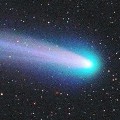
|
It passed only 0.4 A.U. from the earth, and 0.8 A.U. from the sun in November and December in 2013, and brightened up to 4.7 mag (Nov. 28, Juan Jose Gonzalez). Now it is 16.2 mag (Aug. 12, Taras Prystavski). It keeps observable until early September in the Northern Hemisphere, or early November in the Southern Hemisphere.
Date(TT) R.A. (2000) Decl. Delta r Elong. m1 Best Time(A, h)
Sept. 6 15 44.37 -30 46.7 3.881 3.799 77 15.0 19:47 ( 39, 11)
Sept.13 15 48.59 -31 13.3 4.063 3.876 72 15.2 19:36 ( 41, 9)
|

|
Now it is 15.3 mag (Sept. 1, Catalina Sky Survey). It will be observable at 14.5 mag in excellent condition from October to December.
Date(TT) R.A. (2000) Decl. Delta r Elong. m1 Best Time(A, h)
Sept. 6 4 14.47 13 41.7 1.292 1.757 98 15.7 4:09 (321, 64)
Sept.13 4 27.50 14 59.5 1.225 1.743 102 15.5 4:15 (330, 68)
|
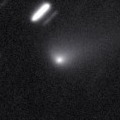
|
It brightened up to 12-13 mag from April to May. Now it is fading. It has already faded down to 15.2 mag (Aug. 12, Taras Prystavski). It will be unobservable in late October.
Date(TT) R.A. (2000) Decl. Delta r Elong. m1 Best Time(A, h)
Sept. 6 15 19.99 -15 10.6 2.919 2.717 68 15.5 19:47 ( 54, 20)
Sept.13 15 30.83 -15 50.6 3.015 2.735 64 15.6 19:36 ( 54, 18)
|
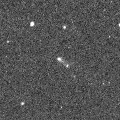
|
Now it is 14.2 mag (Aug. 28, Jakub Cerny). First return of a new periodic comet which brightened up to 13 mag in 2007. It was expected to brighten up to 13 mag again and observable in good condition from summer to autumn in 2014. But actually, it is fainter than expected.
Date(TT) R.A. (2000) Decl. Delta r Elong. m1 Best Time(A, h)
Sept. 6 23 42.75 -11 9.2 1.294 2.290 168 15.5 0:44 ( 0, 44)
Sept.13 23 39.49 -12 22.4 1.292 2.291 170 15.5 0:14 ( 0, 43)
|
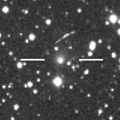
|
It brightened rapidly, and reached up to 14.0 mag (Mar. 28, Sandor Szabo). Now it is 15.2 mag (July 19, Taras Prystavski). It keeps observable in good condition until mid October in the Southern Hemisphere. In the Northern Hemisphere, it locates extremely low and too hard to observe.
Date(TT) R.A. (2000) Decl. Delta r Elong. m1 Best Time(A, h)
Sept. 6 13 57.83 -16 33.8 2.682 2.178 50 15.9 19:47 ( 66, 4)
Sept.13 14 14.60 -16 47.4 2.776 2.219 47 16.1 19:36 ( 66, 4)
|

|
New comet. Now it is 16.0 mag (Aug. 23, J. Hambsch, E. Bryssinck). It will brighten up to 14.5 mag in November. In the Northern Hemisphere, it keeps observable in good condition until the comet will fade out in next spring. In the Southern Hemisphere, it will be unobservable in late September.
Date(TT) R.A. (2000) Decl. Delta r Elong. m1 Best Time(A, h)
Sept. 6 6 13.87 27 0.8 2.004 1.912 70 16.3 4:09 (268, 50)
Sept.13 6 22.85 30 41.4 1.853 1.868 75 16.1 4:15 (266, 56)
|
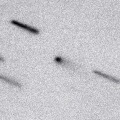
|
Now it is 15.8 mag (July 20, Toshiyuki Takahashi). In the Northern Hemisphere, it will be getting higher gradually after this, and keeps observable in good condition while the comet will be fading gradually. In the Southern Hemisphere, it keeps extremely low.
Date(TT) R.A. (2000) Decl. Delta r Elong. m1 Best Time(A, h)
Sept. 6 7 15.71 29 34.7 1.940 1.626 56 16.1 4:09 (258, 38)
Sept.13 7 36.34 30 11.5 1.916 1.650 59 16.2 4:15 (258, 41)
|
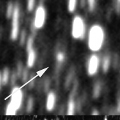
|
Now it is 16.2 mag (Aug. 24, Jean-Francois Viens). Distant object, but it keeps observable at 14 mag for a long time from 2015 to 2016.
Date(TT) R.A. (2000) Decl. Delta r Elong. m1 Best Time(A, h)
Sept. 6 18 52.69 -4 22.9 6.039 6.587 118 16.1 19:51 ( 0, 51)
Sept.13 18 52.72 -4 45.1 6.103 6.556 112 16.1 19:36 ( 5, 50)
|
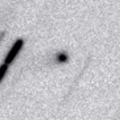
|
Now it is 16.1 mag (July 30, Taras Prystavski). It is expected to brighten up to 14 mag from 2015 to 2016. It is observable in good condition in the Southern Hemisphere. It locates somewhat low in the Northern Hemisphere.
Date(TT) R.A. (2000) Decl. Delta r Elong. m1 Best Time(A, h)
Sept. 6 5 34.45 -20 49.0 5.161 5.152 83 16.2 4:09 (322, 24)
Sept.13 5 32.60 -21 21.9 5.033 5.120 89 16.1 4:15 (331, 28)
|
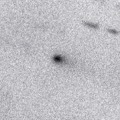
|
Now it is 15.7 mag (July 29, Taras Prystavski). It will be fading gradually after this. It keeps observable until next February when the comet will be fainter than 18 mag. In the Northern Hemispehre, it keeps observable in excellent condition. It locates somewhat low in the Southern Hemisphere.
Date(TT) R.A. (2000) Decl. Delta r Elong. m1 Best Time(A, h)
Sept. 6 7 1.05 19 3.1 2.034 1.740 58 16.1 4:09 (271, 36)
Sept.13 7 16.30 18 32.1 2.014 1.778 61 16.2 4:15 (275, 40)
|
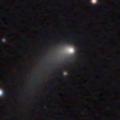
|
Now it is 15.1 mag (Aug. 27, Sandor Szabo). It will be fading after this. In the Northern Hemisphere, it keeps observable until October when the comet will fade down to 17.5 mag. It will never be observable in the Southern Hemisphere.
Date(TT) R.A. (2000) Decl. Delta r Elong. m1 Best Time(A, h)
Sept. 6 13 57.91 33 21.0 2.958 2.427 49 16.2 19:47 (111, 31)
Sept.13 14 10.73 30 31.2 3.054 2.489 47 16.4 19:36 (108, 29)
|
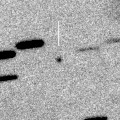
|
It keeps 14-15 mag for a long time from 2014 autumn to 2015 autumn. In the Southern Hemisphere, it keeps observable in excellent condition for a long time. In the Northern Hemisphere, it is only observable in the low sky from September to October. Then it will be unobservable until 2015 June.
Date(TT) R.A. (2000) Decl. Delta r Elong. m1 Best Time(A, h)
Sept. 6 9 2.38 -18 11.8 3.593 2.864 37 16.5 4:09 (286, -9)
Sept.13 9 6.35 -20 11.4 3.485 2.809 41 16.4 4:15 (292, -5)
|
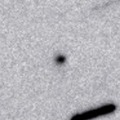
|
Now it is 16.9 mag (July 30, Taras Prystavski). It keeps observable at 15-16 mag for a long time from 2015 to 2016. In the Northern Hemisphere, it is observable in excellent condition. It locates somewhat low in the Southern Hemisphere.
Date(TT) R.A. (2000) Decl. Delta r Elong. m1 Best Time(A, h)
Sept. 6 4 11.45 19 3.5 5.736 5.972 98 16.6 4:09 (314, 69)
Sept.13 4 11.07 19 37.6 5.598 5.946 105 16.5 4:15 (335, 73)
|

|
It brightened up to 12-13 mag from 2012 to 2013. Now it is fading. But it is bright as 15.3 mag still now (Aug. 31, Toshiyuki Takahashi). It keeps 16-17 mag until autumn, and will be observable in good condition.
Date(TT) R.A. (2000) Decl. Delta r Elong. m1 Best Time(A, h)
Sept. 6 0 53.16 -16 37.8 3.076 3.982 150 16.6 1:55 ( 0, 38)
Sept.13 0 49.27 -17 11.0 3.064 3.999 155 16.7 1:23 ( 0, 38)
|
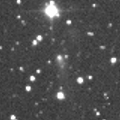
|
It brightened rapidly, and became brighter than originally predicted. Now it is 15.8 mag (Aug. 12, Taras Prystavski). It will be fading after this. It keeps observable until late September in the Northern Hemisphere, or early November in the Southern Hemisphere.
Date(TT) R.A. (2000) Decl. Delta r Elong. m1 Best Time(A, h)
Sept. 6 15 59.83 -25 30.1 4.494 4.430 79 16.8 19:47 ( 39, 18)
Sept.13 16 4.97 -25 42.4 4.613 4.448 74 16.9 19:36 ( 41, 16)
|
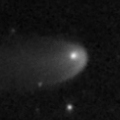
|
Now it is between 15.6 mag (July 7, Taras Prystavski) and 18.2 mag (July 3, K. Hills). It brightened up to 13 mag from 2011 to 2012. It will be fading after this, but it keeps brighter than 18 mag until 2015 spring.
Date(TT) R.A. (2000) Decl. Delta r Elong. m1 Best Time(A, h)
Sept. 6 3 56.34 -4 32.5 8.427 8.755 105 16.9 4:09 (341, 49)
Sept.13 3 55.25 -4 36.5 8.361 8.790 112 16.9 4:15 (355, 50)
|

|
New comet. It will approach to the sun down to 0.3 a.u. in 2015 July, and it is expected to be bright. Now it is 16.7 mag (Aug. 22, iTelescope Observatory, Siding Spring). It keeps observable while the comet will be brightening gradually until January when the comet will be 15 mag. The condition is bad after that and it will be hard to observe. But in the Southern Hemisphere, it will be observable after mid July in 2015, and keeps observable while the comet will be fading gradually. In the Northern Hemisphere, it is extremely hard to observe after 2015.
Date(TT) R.A. (2000) Decl. Delta r Elong. m1 Best Time(A, h)
Sept. 6 23 54.80 -28 11.0 3.722 4.652 154 17.0 0:57 ( 0, 27)
Sept.13 23 48.02 -28 47.1 3.647 4.576 154 16.9 0:22 ( 0, 26)
|

|
Now it is 16.8 mag (Aug. 12, Taras Prystavski). It keeps 17 mag for a long time from 2014 to 2015. It is observable in excellent condition in the Northern Hemisphere. It is observable only until mid September in the Southern Hemisphere.
Date(TT) R.A. (2000) Decl. Delta r Elong. m1 Best Time(A, h)
Sept. 6 15 55.14 32 9.0 4.071 3.901 73 17.0 19:47 ( 98, 54)
Sept.13 16 1.15 31 37.1 4.110 3.892 70 17.0 19:36 ( 98, 52)
|
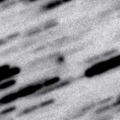
|
Now it is 17.5 mag (June 21, Hidetaka Sato). It will keep 16-17 mag for a long time from 2014 summer to early 2016. It keeps observable in excellent condition until autumn in the Southern Hemisphere. It keeps low in the Northern Hemisphere.
Date(TT) R.A. (2000) Decl. Delta r Elong. m1 Best Time(A, h)
Sept. 6 16 57.13 -23 33.1 2.330 2.578 92 17.0 19:47 ( 28, 26)
Sept.13 17 4.21 -23 29.2 2.392 2.551 87 17.0 19:36 ( 30, 25)
|

|
Now it is 15.7 mag (Sept. 1, Catalina Sky Survey). It will brighten up to 15 mag and will be observable in excellent condition from winter to spring.
Date(TT) R.A. (2000) Decl. Delta r Elong. m1 Best Time(A, h)
Sept. 6 22 55.69 -19 38.0 0.957 1.953 166 17.3 23:53 ( 0, 35)
Sept.13 22 47.95 -20 6.7 0.921 1.903 161 17.0 23:18 ( 0, 35)
|

|
Now it is 17.1 mag (Aug. 30, iTelescope Observatory, Mayhill). It keeps observable at 17-18 mag from August to November in excellent condition in the Northern Hemisphere. It locates somewhat low in the Southern Hemisphere.
Date(TT) R.A. (2000) Decl. Delta r Elong. m1 Best Time(A, h)
Sept. 6 5 38.84 22 12.1 1.186 1.389 78 17.2 4:09 (281, 55)
Sept.13 6 0.74 22 33.0 1.166 1.398 79 17.1 4:15 (283, 57)
|

|
Now it is 17.4 mag (Aug. 5, A. Klotz, F. Kugel, C. Rinner, J. Nicolas). It will brighten up to 15 mag and will be observable in excellent condition from November to February in the Northern Hemisphere. It locates somewhat low in the Southern Hemisphere.
Date(TT) R.A. (2000) Decl. Delta r Elong. m1 Best Time(A, h)
Sept. 6 5 56.96 30 53.5 2.641 2.553 73 17.3 4:09 (264, 55)
Sept.13 6 8.06 30 49.5 2.549 2.543 78 17.1 4:15 (267, 59)
|
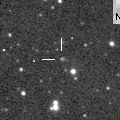
|
It will brighten up to 16 mag in winter, and will be observable in excellent condition.
Date(TT) R.A. (2000) Decl. Delta r Elong. m1 Best Time(A, h)
Sept. 6 7 36.50 18 21.6 4.667 4.098 50 17.2 4:09 (267, 29)
Sept.13 7 43.66 17 55.5 4.582 4.095 55 17.1 4:15 (271, 34)
|
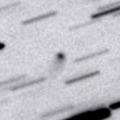
|
Now it is 17.6 mag (Aug. 19, Yasukazu Ikari). It keeps observable at 18 mag for a long time from 2013 to 2016. It keeps locating high in the Northern Hemisphere. It keeps locating very low in the Southern Hemipshere.
Date(TT) R.A. (2000) Decl. Delta r Elong. m1 Best Time(A, h)
Sept. 6 16 51.67 47 33.5 6.490 6.464 84 17.2 19:47 (129, 65)
Sept.13 16 49.14 46 53.2 6.540 6.465 81 17.2 19:36 (125, 62)
|

|
Now it is 17.4 mag (Aug. 2, iTelescope Observatory, Siding Spring). It keeps observable at 17-18 mag from summer to winter in excellent condition in the Northern Hemisphere. It locates somewhat low in the Southern Hemisphere.
Date(TT) R.A. (2000) Decl. Delta r Elong. m1 Best Time(A, h)
Sept. 6 6 10.72 18 9.9 2.372 2.249 70 17.3 4:09 (280, 46)
Sept.13 6 21.60 18 11.0 2.316 2.271 74 17.3 4:15 (285, 51)
|

|
Now it is 17.2 mag (Aug. 24, Jean-Francois Viens). It has brightened in outburst up to 14 mag twice, in 2006 January and 2011 May. It will pass the perihelion in 2015. It keeps observable at 17 mag for a long time after this.
Date(TT) R.A. (2000) Decl. Delta r Elong. m1 Best Time(A, h)
Sept. 6 20 55.05 -14 14.9 5.033 5.920 148 17.3 21:53 ( 0, 41)
Sept.13 20 53.38 -14 26.7 5.091 5.913 141 17.4 21:24 ( 0, 41)
|
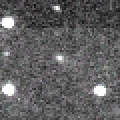
|
Now it is 17.9 mag (Aug. 5, Ken-ichi Kadota). It keeps observable at 17-18 mag in good condition from July to October.
Date(TT) R.A. (2000) Decl. Delta r Elong. m1 Best Time(A, h)
Sept. 6 22 2.01 -15 7.8 1.521 2.505 163 17.4 23:00 ( 0, 40)
Sept.13 21 58.32 -14 58.0 1.544 2.499 156 17.4 22:29 ( 0, 40)
|

|
It will brighten up to 14 mag around the perihelion passage in 2019. In 2014, it will be observable in excellent condition at 17 mag from summer to winter in the Northern Hemisphere. It locates extremely low in the Southern Hemisphere. However, it is faint as 18.9 mag now, much fainter than this ephemeris (Aug. 5, Ken-ichi Kadota).
Date(TT) R.A. (2000) Decl. Delta r Elong. m1 Best Time(A, h)
Sept. 6 3 27.70 34 42.2 12.267 12.554 104 17.4 4:09 (272, 86)
Sept.13 3 27.04 34 58.1 12.133 12.527 110 17.4 4:01 (180, 90)
|

|
First return of a new periodic comet discovered in 2005. It was expected to be observable at 17 mag for a long time from 2013 to 2014. However, it has not been recovered yet. Actually, it is much fainter than predicted, fainter than 20.5 mag (Aug. 1, Jean-Francois Soulier).
Date(TT) R.A. (2000) Decl. Delta r Elong. m1 Best Time(A, h)
Sept. 6 22 49.20 -11 59.7 2.382 3.387 174 17.5 23:47 ( 0, 43)
Sept.13 22 45.04 -12 35.9 2.408 3.397 167 17.5 23:15 ( 0, 42)
|

|
Now it is 19.7 mag (July 30, iTelescope Observatory, Siding Spring). It will brighten up to 9 mag in 2015 spring. But the condition of this apparition is bad. In the Southern Hemisphere, it keeps observable until winter when the comet will be 13 mag. But it is not observable around the brightest days. In the Northern Hemispehre, it keeps extremely low and hard to observe. It will be observable after 2015 autumn when the comet will fade out.
Date(TT) R.A. (2000) Decl. Delta r Elong. m1 Best Time(A, h)
Sept. 6 20 28.96 -55 1.1 2.242 2.919 123 17.9 21:27 ( 0, 0)
Sept.13 20 22.66 -54 43.2 2.263 2.872 117 17.7 20:53 ( 0, 0)
|

|
It keeps 17.5 mag and will be observable in excellent condition from autumn to winter in the Northern Hemisphere. It locates somewhat low in the Southern Hemisphere. However, it is actually 19.7 mag, much fainter than predicted (Sept. 3, Jean-Francois Soulier).
Date(TT) R.A. (2000) Decl. Delta r Elong. m1 Best Time(A, h)
Sept. 6 5 59.03 25 42.9 1.503 1.552 73 17.8 4:09 (272, 52)
Sept.13 6 18.87 24 37.2 1.465 1.559 75 17.8 4:15 (276, 55)
|

|
It will pass close to the earth from spring to summer in 2016, and it is expected to be observable at 6-7 mag in good condition. Now it is 18.3 mag (Aug. 25, K. Sarneczky). In the Northern Hemispehre, it keeps observable in good condition until 2015 spring when the comet will brighten up to 15.5 mag. In the Southern Hemisphere, it keeps low for a long time until 2016 spring.
Date(TT) R.A. (2000) Decl. Delta r Elong. m1 Best Time(A, h)
Sept. 6 6 59.20 32 11.9 7.144 6.712 60 18.0 4:09 (256, 42)
Sept.13 7 0.48 32 22.3 6.975 6.653 67 17.9 4:15 (259, 49)
|
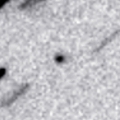
|
It was observed at 17.5 mag in early 2013. It was predicted to be observable at 17.5 mag again from spring to summer in 2014. But actually, it is 20.6 mag (June 21, Hidetaka Sato), much fainter than predicted by 3 mag.
Date(TT) R.A. (2000) Decl. Delta r Elong. m1 Best Time(A, h)
Sept. 6 19 5.76 -19 49.8 2.516 3.171 122 22.1 20:04 ( 0, 35)
Sept.13 19 7.75 -20 11.7 2.624 3.195 115 22.3 19:39 ( 0, 35)
|
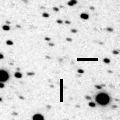
|
It was discovered in 1819, and re-discovered in 2003. Although it was predicted to be extremely faint as 26 mag, it unusually brightened up to 17.5 mag in outburst in 2013 July (July 6, Hidetaka Sato). However, no observations have been reported since mid July. It will pass the perihelion in 2014 August, and will approach to the sun down to 0.96 a.u. The brightness is predicted to be 23 mag at best. However, if the cometary activity continues, it may be observed brighter. Ken-ichi Kadota reported it was not detected, fainter than 16.3 mag, on May 21.
Date(TT) R.A. (2000) Decl. Delta r Elong. m1 Best Time(A, h)
Sept. 6 8 41.83 19 37.7 1.594 0.969 35 22.9 4:09 (257, 16)
Sept.13 9 13.02 18 1.2 1.631 0.988 34 23.0 4:15 (259, 16)
|
|
![]()
 C/2014 Q2 ( Lovejoy )
C/2014 Q2 ( Lovejoy ) P/2014 L2 ( NEOWISE )
P/2014 L2 ( NEOWISE ) C/2010 S1 ( LINEAR )
C/2010 S1 ( LINEAR ) C/2013 US10 ( Catalina )
C/2013 US10 ( Catalina ) C/2014 R1 ( Borisov )
C/2014 R1 ( Borisov ) C/2013 UQ4 ( Catalina )
C/2013 UQ4 ( Catalina ) C/2011 J2 ( LINEAR )
C/2011 J2 ( LINEAR ) C/2012 F3 ( PanSTARRS )
C/2012 F3 ( PanSTARRS ) C/2014 N3 ( NEOWISE )
C/2014 N3 ( NEOWISE ) (596) Scheila
(596) Scheila C/2006 S3 ( LONEOS )
C/2006 S3 ( LONEOS ) 17P/Holmes
17P/Holmes C/2013 R1 ( Lovejoy )
C/2013 R1 ( Lovejoy ) 108P/Ciffreo
108P/Ciffreo 134P/Kowal-Vavrova
134P/Kowal-Vavrova 284P/2013 J1 ( McNaught )
284P/2013 J1 ( McNaught ) C/2013 Y2 ( PanSTARRS )
C/2013 Y2 ( PanSTARRS ) C/2014 Q3 ( Borisov )
C/2014 Q3 ( Borisov ) 106P/Schuster
106P/Schuster C/2011 KP36 ( Spacewatch )
C/2011 KP36 ( Spacewatch ) C/2014 A4 ( SONEAR )
C/2014 A4 ( SONEAR ) 16P/Brooks 2
16P/Brooks 2 C/2013 V1 ( Boattini )
C/2013 V1 ( Boattini ) C/2014 AA52 ( Catalina )
C/2014 AA52 ( Catalina ) C/2013 V4 ( Catalina )
C/2013 V4 ( Catalina ) 246P/2010 V2 ( NEAT )
246P/2010 V2 ( NEAT ) P/2012 B1 ( PanSTARRS )
P/2012 B1 ( PanSTARRS ) C/2009 F4 ( McNaught )
C/2009 F4 ( McNaught ) C/2014 Q1 ( PanSTARRS )
C/2014 Q1 ( PanSTARRS ) C/2013 G3 ( PanSTARRS )
C/2013 G3 ( PanSTARRS ) 44P/Reinmuth 2
44P/Reinmuth 2 201P/LONEOS
201P/LONEOS 304P/2014 L4 ( Ory )
304P/2014 L4 ( Ory ) 110P/Hartley 3
110P/Hartley 3 269P/2012 R2 ( Jedicke )
269P/2012 R2 ( Jedicke ) C/2012 K8 ( Lemmon )
C/2012 K8 ( Lemmon ) 191P/McNaught
191P/McNaught 174P/(60558) 2000 EC98 ( Echeclus )
174P/(60558) 2000 EC98 ( Echeclus ) 303P/2014 L1 ( NEAT )
303P/2014 L1 ( NEAT ) C/2010 U3 ( Boattini )
C/2010 U3 ( Boattini ) P/2005 L1 ( McNaught )
P/2005 L1 ( McNaught ) 19P/Borrelly
19P/Borrelly 11P/Tempel-Swift-LINEAR
11P/Tempel-Swift-LINEAR C/2013 X1 ( PanSTARRS )
C/2013 X1 ( PanSTARRS ) 280P/2013 C1 ( Larsen )
280P/2013 C1 ( Larsen ) 289P/Blanpain
289P/Blanpain![]()










































